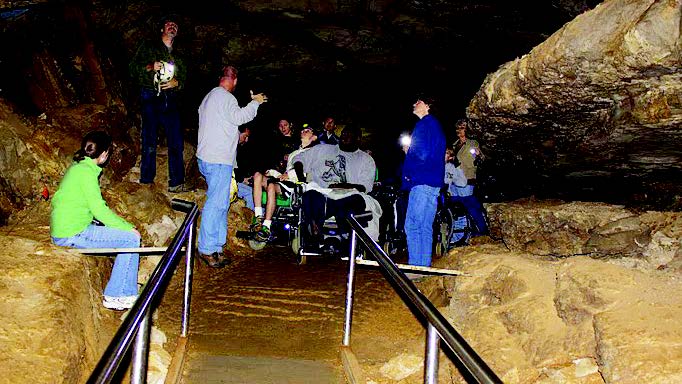above: Students with mobility impairments are led through Mammoth Cave by Georgia State's Christopher Atchison. An OSC study aims to further develop a virtual cave system to increase career opportunities in the geosciences.
College geoscience students with mobility impairments soon will be able to explore a computer simulation of a large cave system to meet degree requirements of field-based learning experiences.
A research team led by visualization experts at the Ohio Supercomputer Center (OSC) and a geoscience researcher at Georgia State University (GSU) seeks to develop an interactive, virtual field trip through a portion of Kentucky’s famous Mammoth Cave – the world’s longest known cave, with nearly 400 miles of interconnected chambers and passages. The two-year National Science Foundation project will develop an alternative to the physically demanding conditions normally encountered during field study, conditions that have led to an underrepresentation of geoscience graduates with mobility impairments.
“Although there are many sub-disciplines within the geosciences that create different opportunities, this science does not lend itself well to those who are physically unable to venture past the controlled laboratory setting,” said Christopher Atchison, Ph.D., recently a graduate research assistant at OSC and now an assistant professor of geoscience education at GSU.
In addition to structural data previously obtained, the team will gather high-precision data through laser remote-sensing technology, called LIDAR (Light Detection And Ranging), and high-resolution digital photography of specific geological formations.
The data will be integrated into a virtual environment that can be explored and evaluated for usability by a representative group of students with mobility impairments.
“Through this experience, students will better inform the creation and development of a synthetic environment tailored to emulate a geological field study,” explained Don Stredney, OSC senior research scientist for biomedical applications and director of the center’s Interface Laboratory. “Additionally, the students’ experiences will assist the developers in creating an environment that is tailored to their abilities, as well as in establishing a sense of realism based on their experiences within the actual field site.”
The interdisciplinary effort includes individuals with expertise in modeling and simulation, virtual environments, human factors, geosciences and testing. The team is collaborating with members of the Mammoth Cave International Center for Science and Learning, the Advanced Computing Center for the Arts and Design at The Ohio State University (OSU), the School of Teaching and Learning in OSU’s Collge of Education, the National Cave and Karst Research Institute, the Cave Research Foundation, Ohio’s STEM Ability Alliance and the International Advisory for Geo-science Diversity. The team seeks to prove the vast potential for a simulated field experience and lead to an even broader study of a virtual field education module that can be used by all students.
--
Project lead: Don Stredney, Ohio Supercomputer Center
Research title: Expanding geoscience diversity through simulated field environments for students with physical disabilities
Funding source: National Science Foundation
